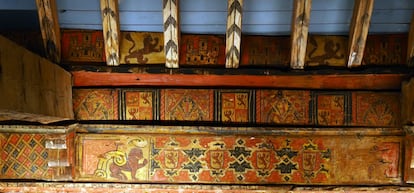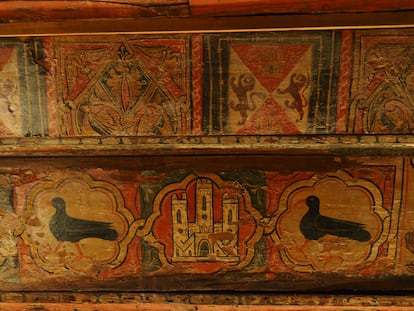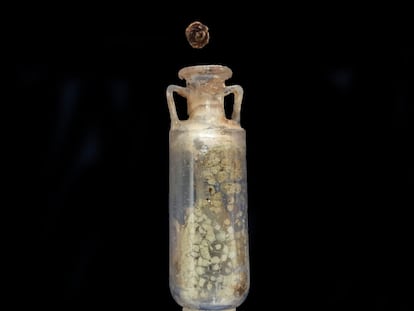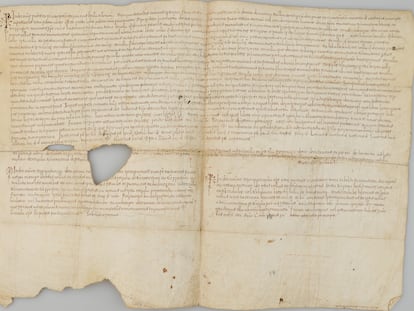Queen Berengaria’s sad message hidden in the ceiling of a Spanish convent
More than 150 heraldic coats of arms tell the unhappy story of the woman who Pope Innocent III forced to separate from King Alfonso IX of León when they already had five children together


Queen Berengaria I of Castile (1180-1246) was also queen consort of the Kingdom of León by her marriage to Alfonso IX, but Pope Innocent III annulled the marriage seven years after the union and after five children had already been born. The reason given was that the spouses were first cousins once removed. Berengaria (known as Berenguela in Spanish) never got over the emotional and political blow that forced her to return to Castile and take refuge under the protection of her royal parents: Alfonso VIII, victor of the Battle of Navas de Tolosa, and Eleanor Plantagenet, daughter of King Henry II of England and Eleanor of Aquitaine, muse of the troubadours. A life, therefore, marked by the political and personal interests of others. For example, the Duke of Rothenburg, fifth son of the Holy Roman Emperor Frederick I Barbarossa, became engaged to her when she was only nine years old, but finally broke off the agreement when he learned that Berengaria had a new brother (Henry I), which meant that the German aristocrat lost his possible dynastic rights through marriage.
Shortly before her death, Berengaria decided to write her eventful story. Scholars Charo García de Arriba and Miguel Ángel Martín Mas have found where. It was encrypted and painted on the ceiling of the Real Convento de Santa Clara, in Salamanca, Spain. The convent was founded around 1238. Until now, it was believed that the one hundred and fifty or so emblems and heraldic coats of arms painted on the coffered ceiling were those of the city’s most important families so that their generous patronage of the religious building would be remembered by posterity. But in the 18th century, the nuns of the Poor Clares decided to build a new church, and so the ceiling whose frieze was decorated with lions, birds, castles and coats of arms was hidden between a false vault and the convent’s roof. Fifty years ago, during construction work, the original ceiling was uncovered. The colorful ceiling can now be visited thanks to a system of walkways that allows you to see the decoration in detail.
The accepted interpretation that these were heraldic elements of the city remained until Raúl de Tapia Martín, biologist and director of the Tormes-EB Foundation, made it public that the bird represented several times on the coffered ceiling, a chough, was not typical of the Salamanca area, but rather of the mountainous areas of the Iberian Peninsula and the cliffs of the British Isles. And so a logical question arose: why would someone paint this particular bird in a church in Salamanca?
García de Arriba and Martín Mas began to “weigh the options” to justify the presence of the corvid. They realized that the chough is the emblem of St. Thomas Becket, whose assassination in 1170 was precipitated by Henry II of England, Berengaria’s grandfather. After the murder, the repentant king encouraged devotion to the saint, and entrusted this mission to his daughters and granddaughters in the places where they reigned. A kind of family penance. According to one legend, after the archbishop’s murder, a passing crow entered the cathedral and, landing on the corpse, dipped its beak and legs in blood, thus giving the chough its distinctive coloration. Therefore, the coat of arms of the city of Canterbury shows three choughs on a silver field and above them the golden lion of the Plantagenets on a field of gules (red).
“From there we began to discover that the coffered ceiling did not contain isolated coats of arms of the nobles from Salamanca, but that the whole thing told a story. What we saw was in keeping with the vicissitudes experienced by Queen Berengaria, the story of the chronicles was there, only it was told through images. The lions would mark the order of the pages to be read,” explains Martín Mas.

The ceiling, according to the two scholars, tells the story of Berengaria from 1204, the year her marriage to Alfonso IX was annulled, until 1245, the year before her death. “Everything indicates,” García de Arriba says, “that the queen herself came to Salamanca at the end of her life to tell her side of the story and reclaim her position as Queen of León, Lady of Salamanca and, above all, wife of Alfonso IX and mother of Ferdinand III the Saint, conqueror of Córdoba and Seville.”
“We believe it to be something unique in the world. Among other things, heraldry is used to represent the struggle for the succession of the Kingdom of León, the death of Alfonso IX, the accession of Ferdinand III to the throne of León in 1230, and the death of his two wives: Beatrice of Swabia, who died in 1235 (her black eagle is transformed into a band to reflect her death), and Joan of Ponthieu, whose emblems reflect her grief at the loss of two of her five sons,” the scholars note. There is also an “emotional tribute to Berengaria’s grandmother, Eleanor of Aquitaine, to whom the queen offers the Kingdom of León, fruit of the treaty of Benavente.” Signed after the death of Alfonso IX, this pact dispossessed the daughters of his first wife (Teresa of Portugal) of their dynastic rights in favor of his son Ferdinand III.
According to the scholars, the ceiling shows “the queen’s advanced knowledge and education,” as she “makes use of icons to narrate the very personal circumstances of her life through emblems and coats of arms. It is heraldry that ‘talks,’ in the broadest sense of the term.”

Among the symbols used, the large number of different quartered emblems stands out, an innovation introduced to the Iberian Peninsula by Berengaria and a veiled representation of herself with ten different variants. She does so by following codes implicit in the medieval cliché of courtly love, which her grandmother loved so much.
“It is not a tribute to Queen Berengaria, but a tribute from her to the Kingdom of León, to her husband and maternal ancestry, to the empire raised by her grandmother Eleanor of Aquitaine, Queen of England and prime mover in the so-called Angevin Empire, which included England, Ireland and western France.”
If you follow the itinerary marked by the lions on the roof, you can follow the chronology of historical events that García de Arriba and Martín Mas detail exhaustively in a blog. Among them, the stormy struggle for the succession of the kingdom of León and the engagements and marriages of those involved. In fact, the struggle for the Leonese crown is told as a game of chess and a greyhound race. In addition, the rear frieze of the ceiling offers a tribute to the queen’s maternal lineage and the Angevin Empire of the Plantagenet family. Among the historical characters featured are the two widows of Ferdinand II of León (Urraca of Portugal and Urraca López de Haro), Teresa of Portugal, Berengaria herself and her sister Mafalda, Violant of Aragón, and Alfonso X.
Queen Berengaria was an extremely intelligent and capable woman, but one of many forgotten by history in favor of her husbands and sons. She sought peace between the Christian kingdoms, and thanks to her ambition and her extraordinary political skills, she united the kingdoms of Leon and Castile once and for all. All this she left written on the roof timbers of a convent.
Sign up for our weekly newsletter to get more English-language news coverage from EL PAÍS USA Edition
Tu suscripción se está usando en otro dispositivo
¿Quieres añadir otro usuario a tu suscripción?
Si continúas leyendo en este dispositivo, no se podrá leer en el otro.
FlechaTu suscripción se está usando en otro dispositivo y solo puedes acceder a EL PAÍS desde un dispositivo a la vez.
Si quieres compartir tu cuenta, cambia tu suscripción a la modalidad Premium, así podrás añadir otro usuario. Cada uno accederá con su propia cuenta de email, lo que os permitirá personalizar vuestra experiencia en EL PAÍS.
En el caso de no saber quién está usando tu cuenta, te recomendamos cambiar tu contraseña aquí.
Si decides continuar compartiendo tu cuenta, este mensaje se mostrará en tu dispositivo y en el de la otra persona que está usando tu cuenta de forma indefinida, afectando a tu experiencia de lectura. Puedes consultar aquí los términos y condiciones de la suscripción digital.










































